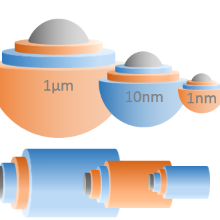Reactive Diffusion in Stressed Nanostructures
In nanoscaled objects, reaction-induced elastic stress and non-equilibrium vacancies can hardly relax. As a result, stresses may become outstandingly high, even approaching the theoretical strength of the material. A better understanding of the interrelation between diffusion, reaction and stress may lead to a perfect control of, for instance, the formation of hollow nanoparticles or hollow nanowires with a wide range of potential applications ranging from photonics to drug delivery.In order to accurately describe these phenomena we are developing a set of analytical equations solved numerically.
These theoretical predictions are then put to the test by creating core-shell nanostructures produced by several techniques like ion beam sputtering, electroetching, electrodeposition… Reactive diffusion is achieved by annealing those nanostructures under different environments (Argon, Oxygen…). An accurate description of the diffusion processes at the atomic scale is then possible using a unique combination of characterization tools (SEM, TEM, Field Ion Microscopy, Atom Probe Tomography…).
Self-assembling nanowires
We are exploring alternative synthesis routes in order to find a new self-ordering way of producing multilayered or core-shell nanowires which would be only based on diffusion processes and phase separation. Simply put, we would like to create a plain alloyed nanowire and provoke the formation of layers just by a well-designed heat treatment.
Since the discovery of giant magnetoresistance, for which Albert Fert and Peter Grünberg have been awarded the 2007 Nobel Prize, thin magnetic films have attracted much interest. More particularly, multi-layered nanowires consisting of magnetic and nonmagnetic layers (FeNi/Cu, Ni/Cu, Fe/Cr, Co/Cu…) have been proven to exhibit outstanding properties which have straightforward applications: M-RAM (magnetic random access memories), nano-sensors, data storage…
Most of the time, the bottle neck for the usage of such nanostructures is that their synthesis is not reliable, especially when it comes to producing very small wires, in the range of a few tens of nanometers diameter. We are exploring alternative synthesis routes in order to find a new self-ordering way of producing multilayered or core-shell nanowires which would be only based on diffusion processes and phase separation. Simply put, we would like to create a plain alloyed nanowire and provoke the formation of layers just by a well-designed heat treatment.




